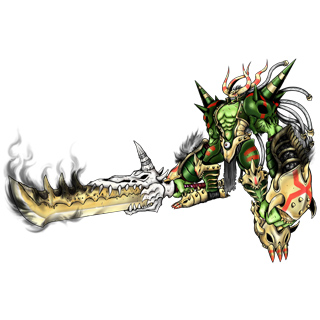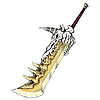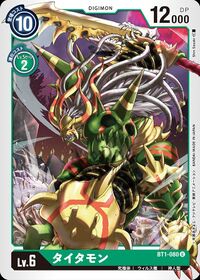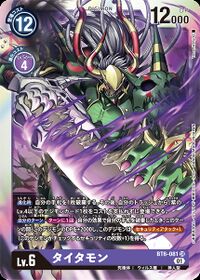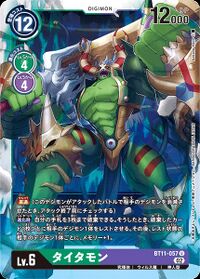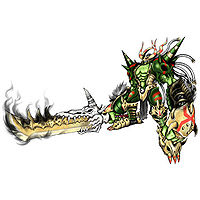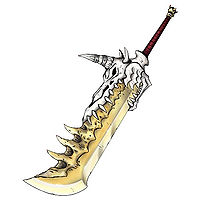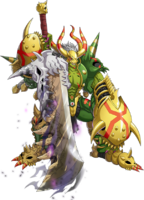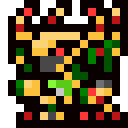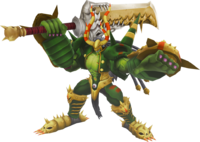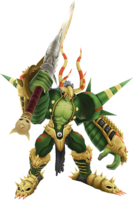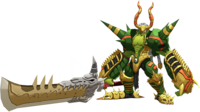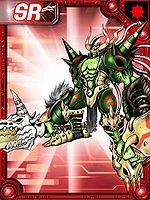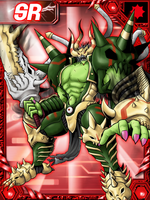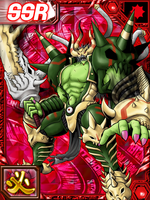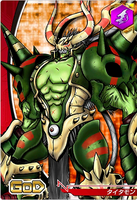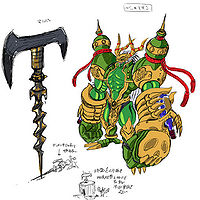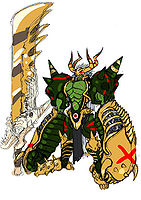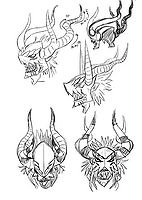Titamon
|
||||||||||||||||||||||||||||||||||||||||||||||||||
Attack Techniques[edit]
| Name | Translation | Kanji/Kana | Romanization | Dub | Description | |
|---|---|---|---|---|---|---|
| Konpaku Shingeki | [2] | Soul Core Attack | 魂魄芯撃 | N/A | Soul Core Attack[5] | Slices through both the armor and body of the enemy in a single slash of the Zanjintou, with enough force to strike their Digicore. |
| Genjin Mukon | [2] | Traceless Phantom Blade | 幻刃無痕 | N/A | Phantom Blade[6] | Torments the enemy with hallucinations after being pierced with the Zanjintou, plaguing their spirit with endless suffering until they die. |
| Koou Meigun | [2] | Dark Army Pact | 呼応冥軍 | N/A | Underworld's Call[4] | Summons phantom warriors with the skulls on both its arms, creating an immortal army which tramples all enemies. |
Evolution[edit]
Evolves From[edit]
- Any Green Lv.5 Digimon from the Digimon Card Game[7]
- Any Purple Lv.5 Digimon from the Digimon Card Game[8]
- Cyberdramon[5][9][10]
- Digitamamon[11][5][9][10][6][12][13][3]
- Orgemon (Warp Evolution)[6]
- Skull Greymon[5][14][15][9][10]
- Zudomon[14][15]
Evolves To[edit]
- Any Digimon that also Evolves from Green Lv.6 Digimon from the Digimon Card Game
- Any Digimon that also Evolves from Purple Lv.6 Digimon from the Digimon Card Game
- Any Green Lv.7 Digimon from the Digimon Card Game
- Any Purple Lv.7 Digimon from the Digimon Card Game
- Belphemon: Rage Mode (with Belphemon: Sleep Mode)[13]
- Omegamon Alter-B (with Metal Etemon)[14][15]
Appearances[edit]
Anime[edit]
Manga[edit]
Video Games[edit]
Digimon World Re:Digitize Decode[edit]
Titamon appears in the Scheme of the Demon Lords chapter (策謀の魔王篇 Sakubō no Maō-hen), where it evolves from Digitamamon to stop Demon and Lucemon: Falldown Mode. It is also an obtainable Digimon which is evolved from Digitamamon. It can also be obtained as a collectible card. Its card is part of the The Ogre's Way of Life (鬼の生き様 Oni no Ikizama) set.
A Titamon without a Tamer can be fought in the Colosseum 40th floor Free Battle: "Fierce One-Man Army". This awards Taiga a Titamon card.
 Lucemon: Falldown Mode facing Digimaru and Titamon |
Digimon Collectors[edit]
Digimon Crusader[edit]
Titamon sends his subordinates to search for Aegiomon with the intention of ending him under the orders of Plutomon.
Digimon Story: Cyber Sleuth[edit]
Digimon World -next 0rder-[edit]
Titamon appears as a boss battle in Chapter 2, having taken over the Server Tower in order to transmit the BH Program throughout the Digital World in the hopes of plunging it into chaos.
Digimon Linkz[edit]
Digimon World -next 0rder- International Edition[edit]
Digimon Story: Cyber Sleuth Hacker's Memory[edit]
Digimon ReArise[edit]
Digimon Encounters[edit]
Digimon New Century[edit]
Digimon Super Rumble[edit]
Digimon Story: Time Stranger[edit]
Virtual Pets[edit]
Digital Monster Ver.20th[edit]
Digimon Pendulum Ver.20th[edit]
Can be used as a Copymon from Digital Monster Ver.20th.
TCG[edit]
Digimon Card Game
|
| ||||
|
| |||||
Image Gallery[edit]
Virtual Pets[edit]

| |
| Digital Monster Ver.20th | D-1 Grand Prix (Digital Monster Ver.20th) |
